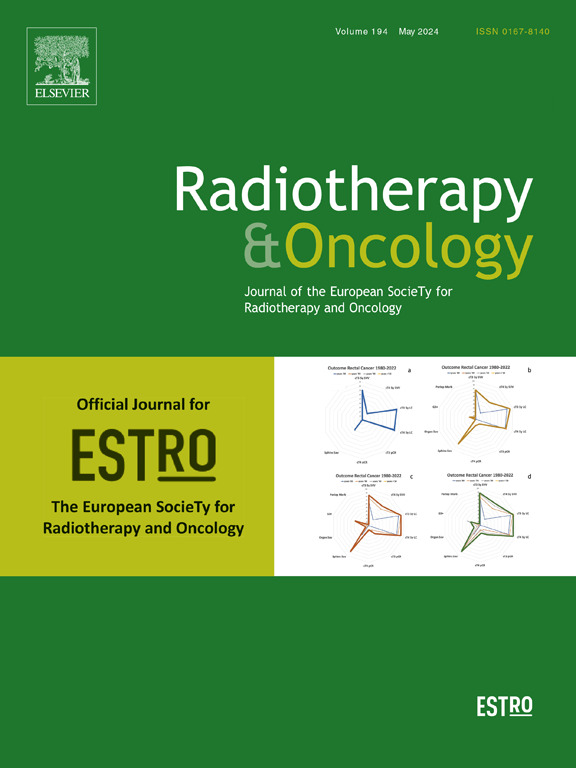鼻咽癌 Ib 级淋巴结转移的风险因素及其选择性预防性照射的临床效果: 一项真实世界研究。
IF 4.9
1区 医学
Q1 ONCOLOGY
引用次数: 0
摘要
目的:评估接受IMRT治疗的鼻咽癌患者发生Ib级淋巴结转移(LNM)的风险因素及其选择性预防性照射(pRT)的临床疗效。方法:收集了518例接受根治性IMRT治疗的鼻咽癌患者,分析了双侧原发肿瘤侵犯结构和颈部LNM水平,以估计Ib级LNM的风险因素。有Ib级LNM和颌下腺(SMG)侵犯的患者接受了Ib级局部放射治疗。比较了省略、接受单侧或双侧Ib级pRT的阴性Ib级LNM患者的Ib级无复发生存率(RFSIb)、区域无复发生存率(RRFS)和IMRT后1年时≥2级口腔异味的发生率:13例(2.5%)患者的18个侧有Ib级LNM。同侧 SMG 受侵是 Ib 级 LNM 的独立风险因素。中位随访时间为98.0个月,IMRT后5年RFSIb、5年RRFS和Ib级LNM阴性患者在IMRT后1年口腔异味≥2级的发生率分别为99.7% vs.100 97.5 % (P = 0.110)、98.0 % vs. 92.1 % vs. 95.1 % (P = 0.120) 和 28.0 % vs. 38.3 % vs. 90.0 % (P 结论:我们的研究表明,同侧 SMG 受侵是 Ib LNM 水平的独立危险因素。没有同侧Ib级LNM和SMG侵犯的患者放弃pRT不会增加RFSIB和RRFS,并降低了口腔异味的发生率。有必要进一步开展多中心前瞻性随机临床试验。本文章由计算机程序翻译,如有差异,请以英文原文为准。
Risk factors of level Ib lymph node metastasis and clinical outcome of its selectively prophylactic irradiation in nasopharyngeal carcinoma: A real-world study
Purpose
To evaluate the risk factor of level Ib lymph node metastasis (LNM) and the clinical outcome of its selectively prophylactic irradiation (pRT) in nasopharyngeal carcinoma (NPC) patients treated with IMRT.
Methods
518 NPC patients receiving radical IMRT were collected. The structures of primary tumor invasions and neck LNM levels were analyzed bilaterally to estimate the risk factors of level Ib LNM. Patients with level Ib LNM and submandibular gland (SMG) invasion received level Ib pRT. The level Ib recurrence-free survival (RFSIb), regional recurrence-free survival (RRFS), and the incidence of ≥ grade 2 xerostomia at 1-year post-IMRT were compared in negative level Ib LNM patients who omitted, received unilateral, or bilateral level Ib pRT.
Results
Thirteen (2.5 %) patients with 18 sides had level Ib LNM. Ipsilateral SMG invasion was an independent risk factor for level Ib LNM. With a median follow-up time of 98.0 months, the 5-year RFSIb, 5-year RRFS and the incidence of xerostomia ≥ grade 2 at 1-year post-IMRT in negative level Ib LNM patients who omitted pRT, received unilateral, bilateral pRT to the level Ib were 99.7 % vs.100 % vs. 97.5 % (P = 0.110), 98.0 % vs. 92.1 % vs. 95.1 % (P = 0.120) and 28.0 % vs. 38.3 % vs. 90.0 % (P < 0.001), respectively.
Conclusions
Our study revealed that ipsilateral SMG invasion was the independent risk factor for the level Ib LNM. Omitting pRT in patients without ipsilateral level Ib LNM and SMG invasion did not increase the RFSIB and RRFS, and reduced the incidence of xerostomia. Further multi-center prospective randomized clinical trial is warranted.
求助全文
通过发布文献求助,成功后即可免费获取论文全文。
去求助
来源期刊

Radiotherapy and Oncology
医学-核医学
CiteScore
10.30
自引率
10.50%
发文量
2445
审稿时长
45 days
期刊介绍:
Radiotherapy and Oncology publishes papers describing original research as well as review articles. It covers areas of interest relating to radiation oncology. This includes: clinical radiotherapy, combined modality treatment, translational studies, epidemiological outcomes, imaging, dosimetry, and radiation therapy planning, experimental work in radiobiology, chemobiology, hyperthermia and tumour biology, as well as data science in radiation oncology and physics aspects relevant to oncology.Papers on more general aspects of interest to the radiation oncologist including chemotherapy, surgery and immunology are also published.
 求助内容:
求助内容: 应助结果提醒方式:
应助结果提醒方式:


